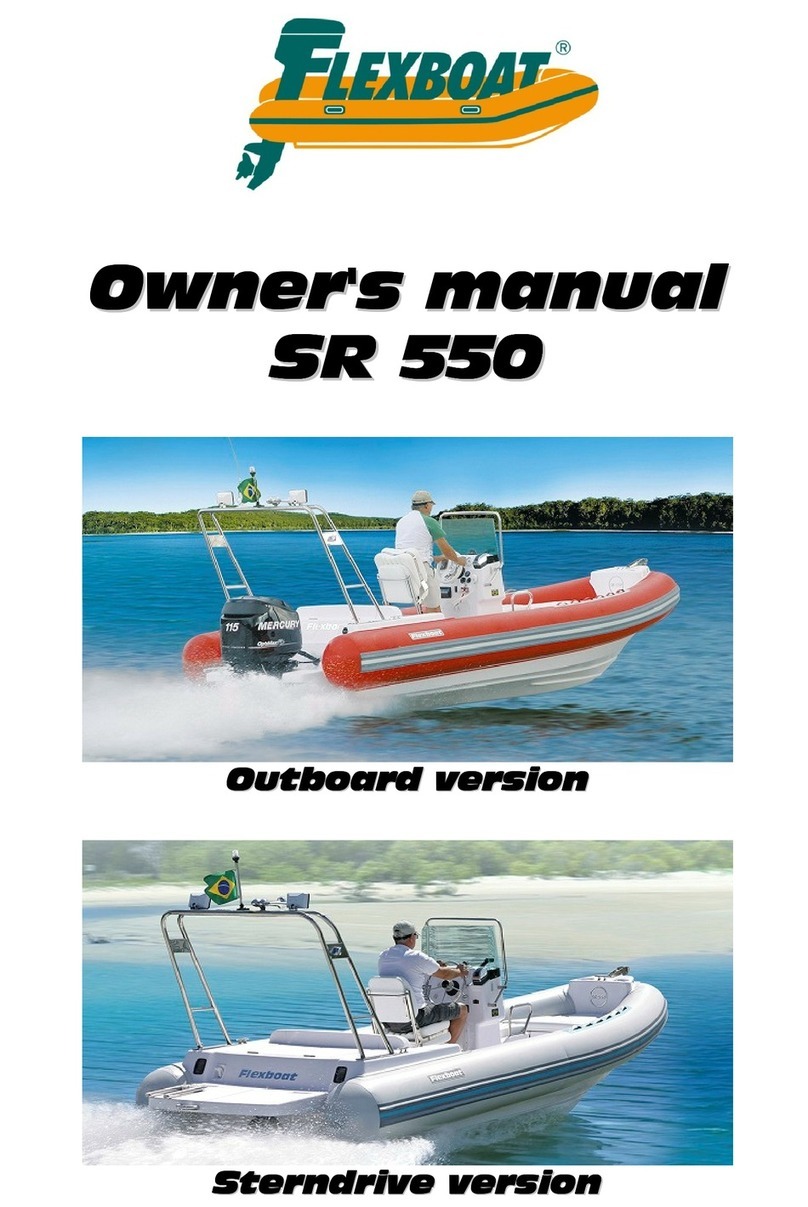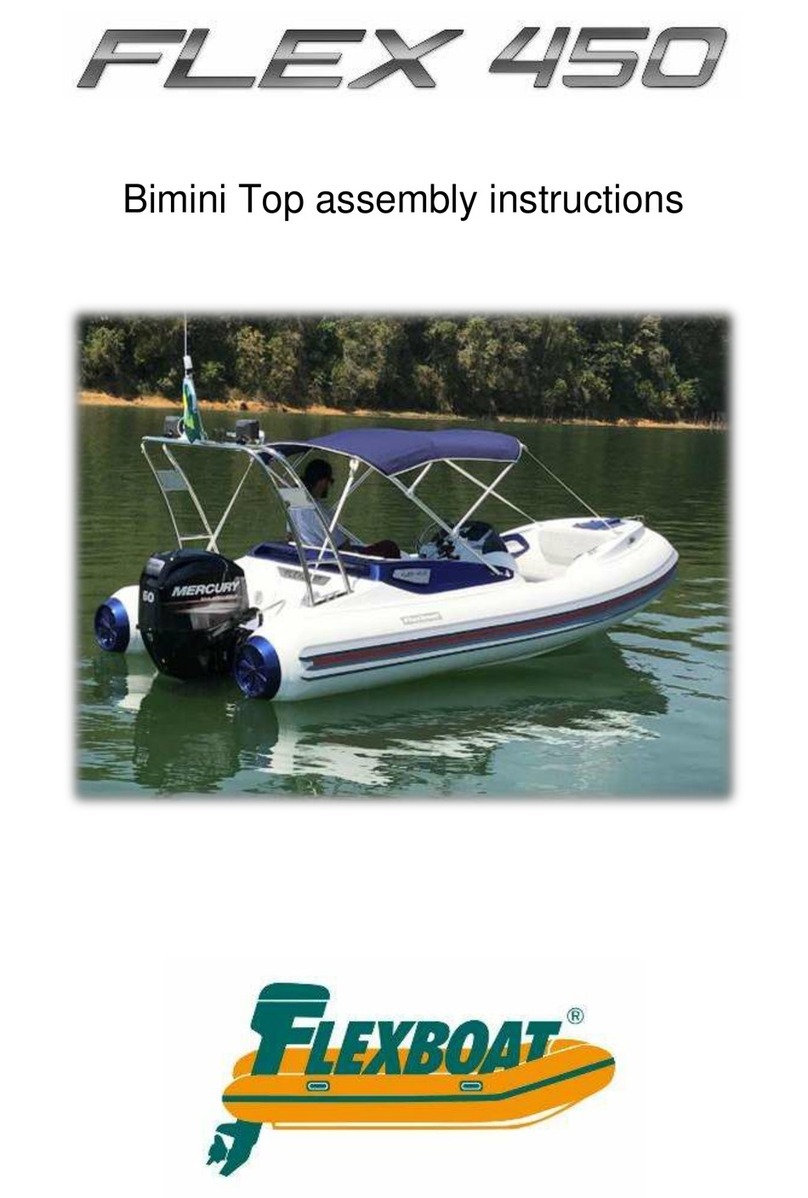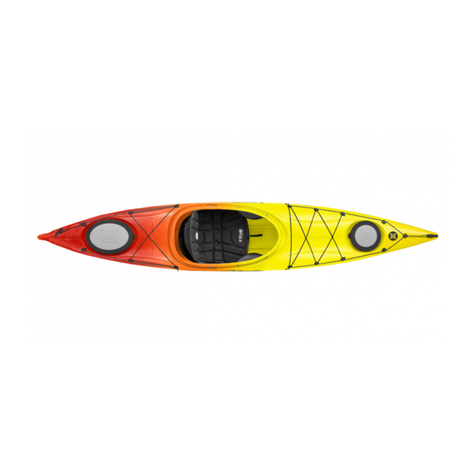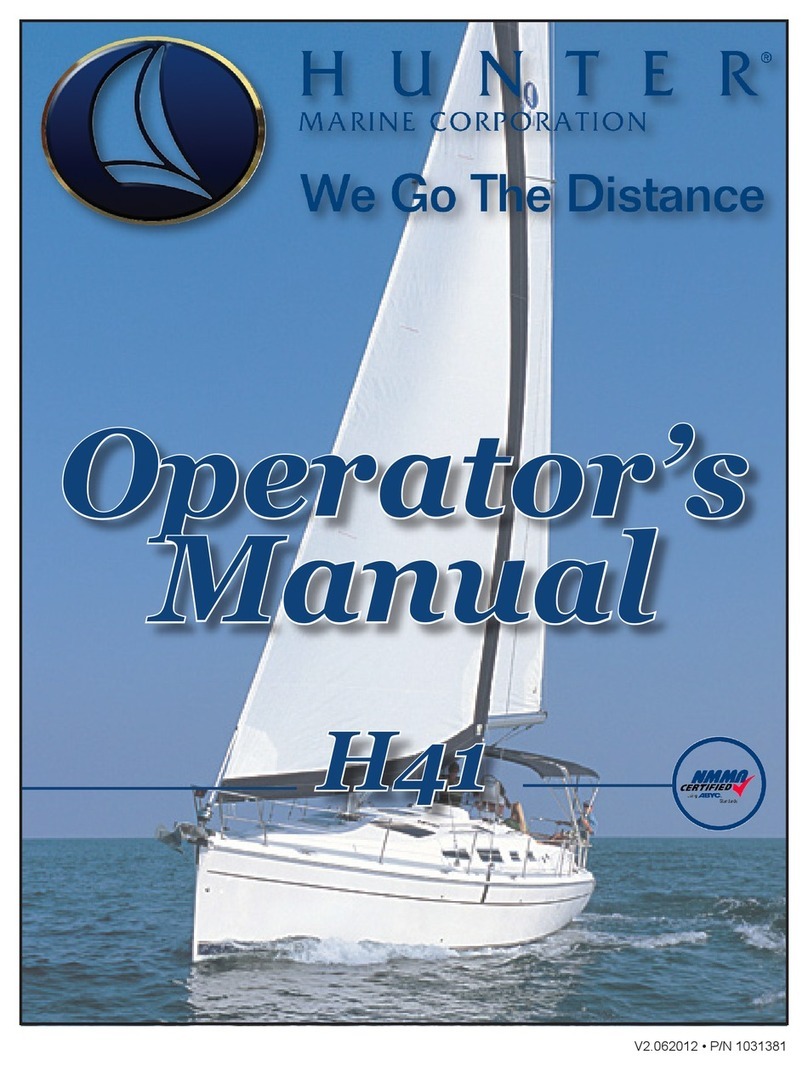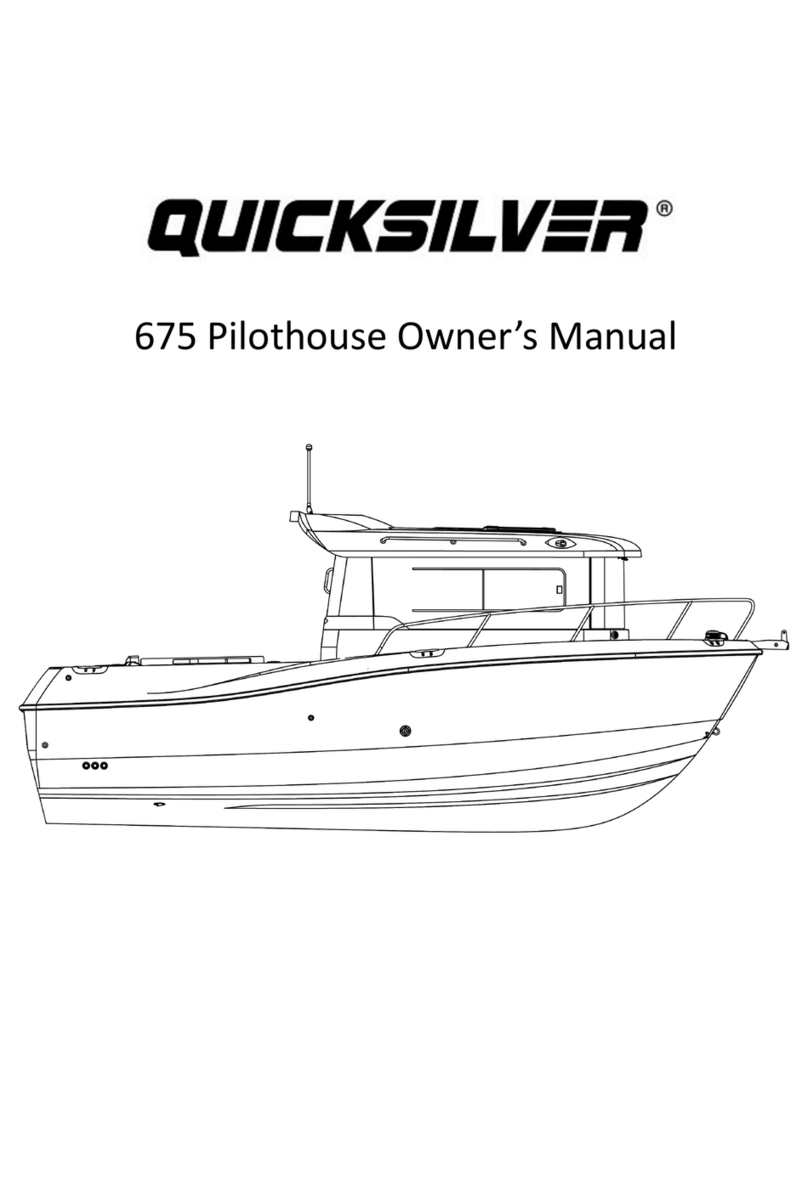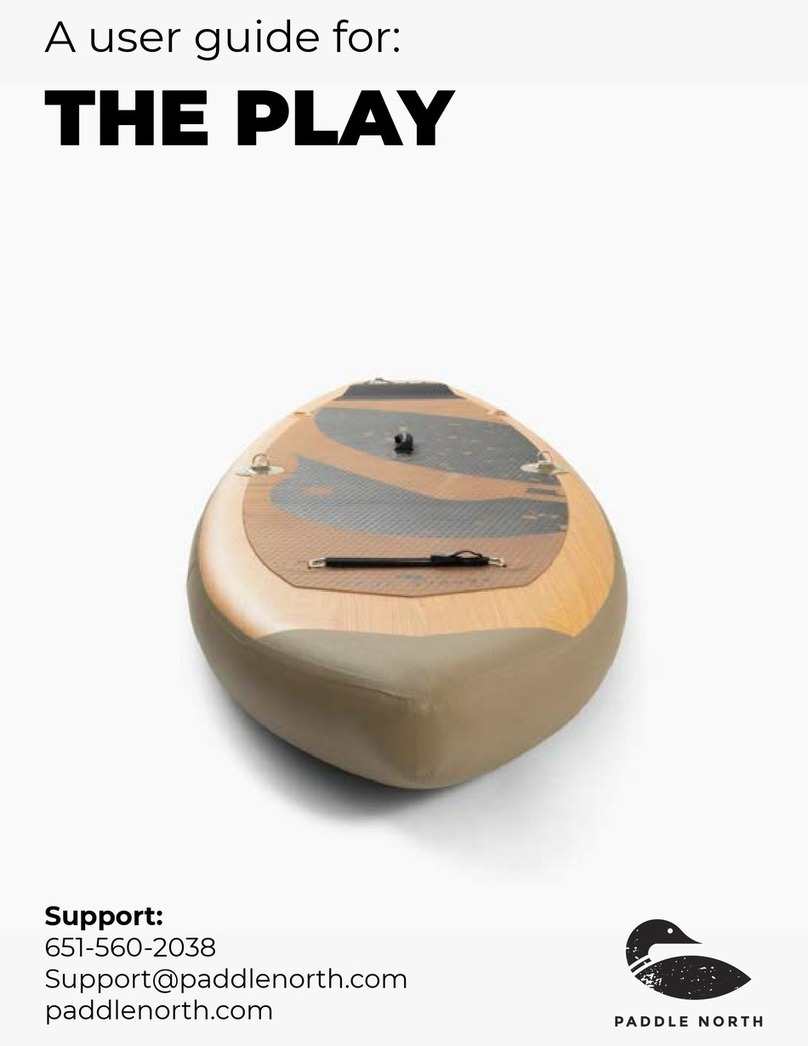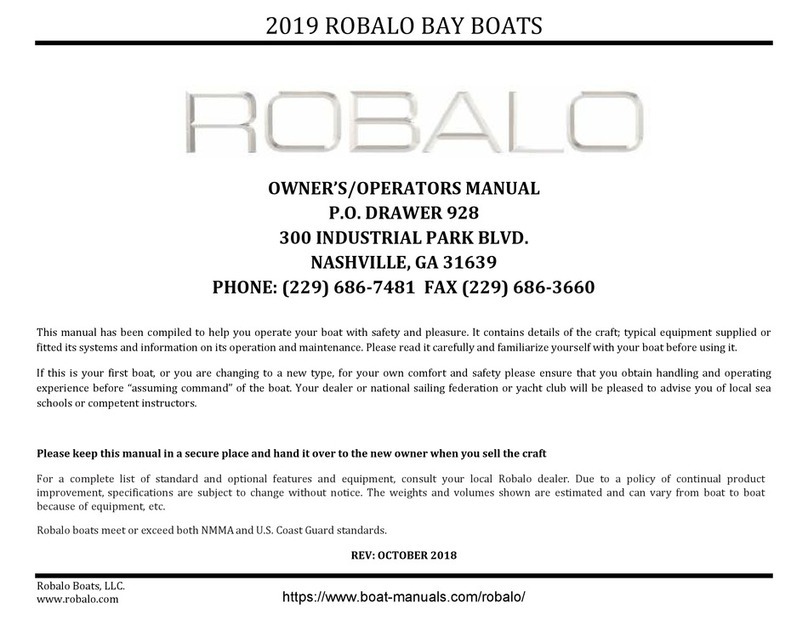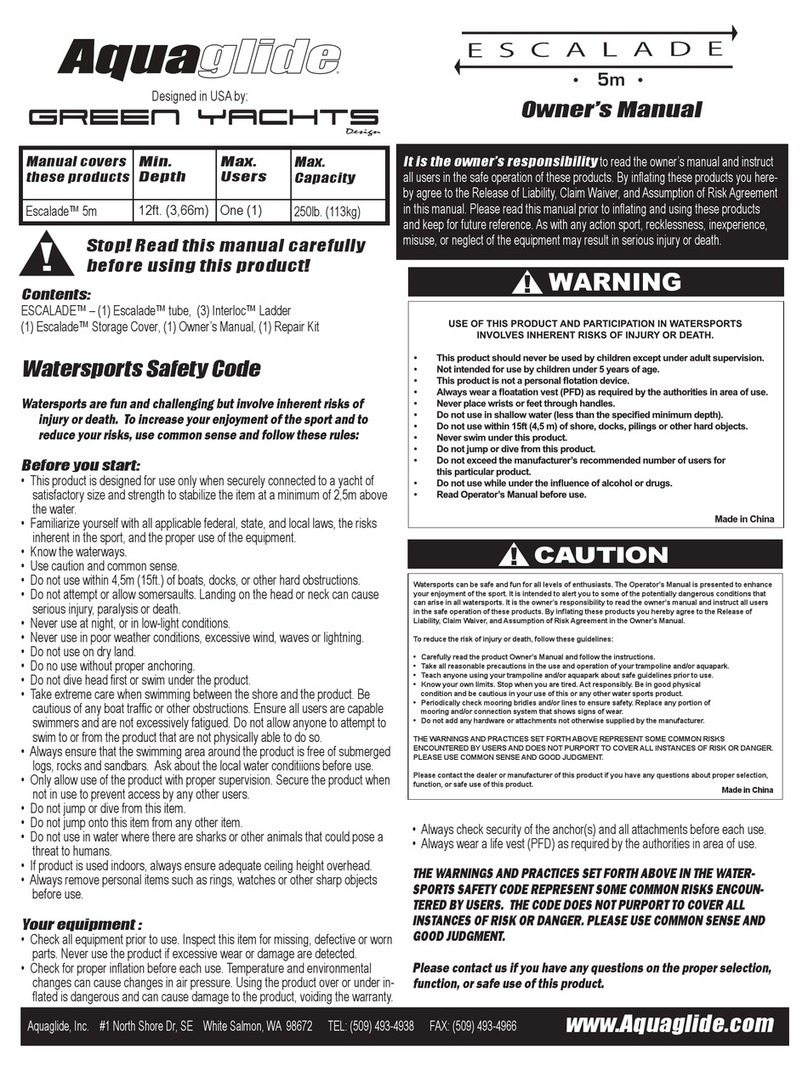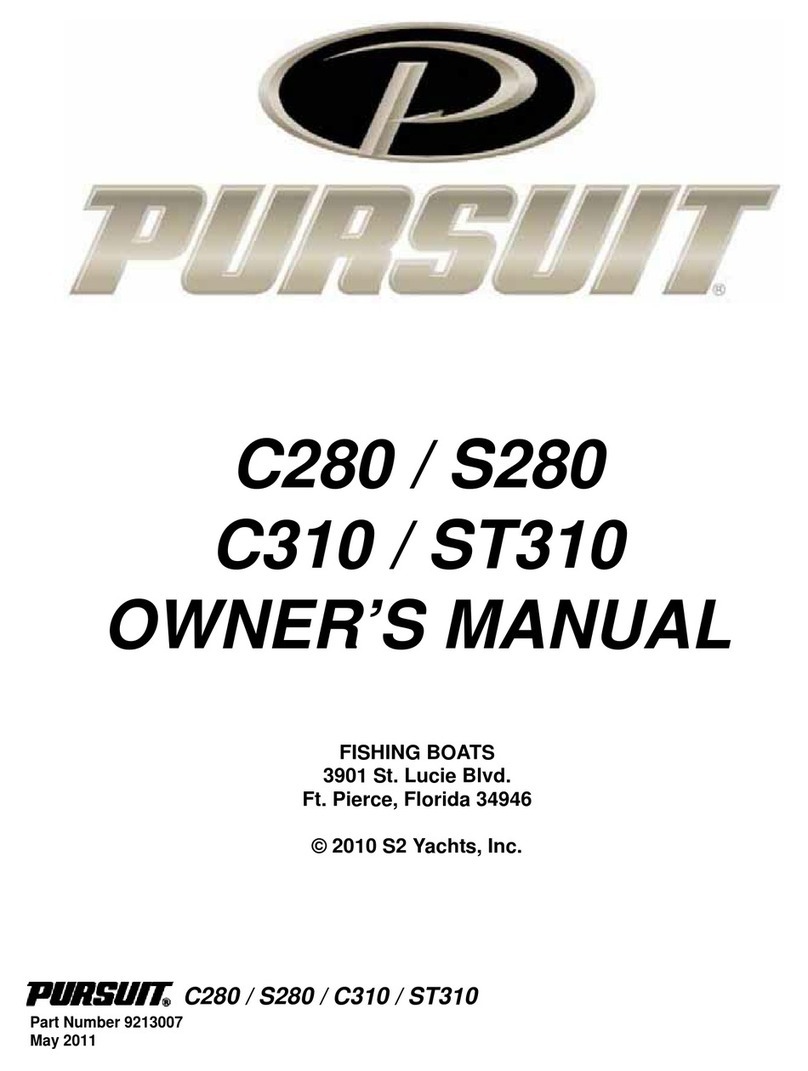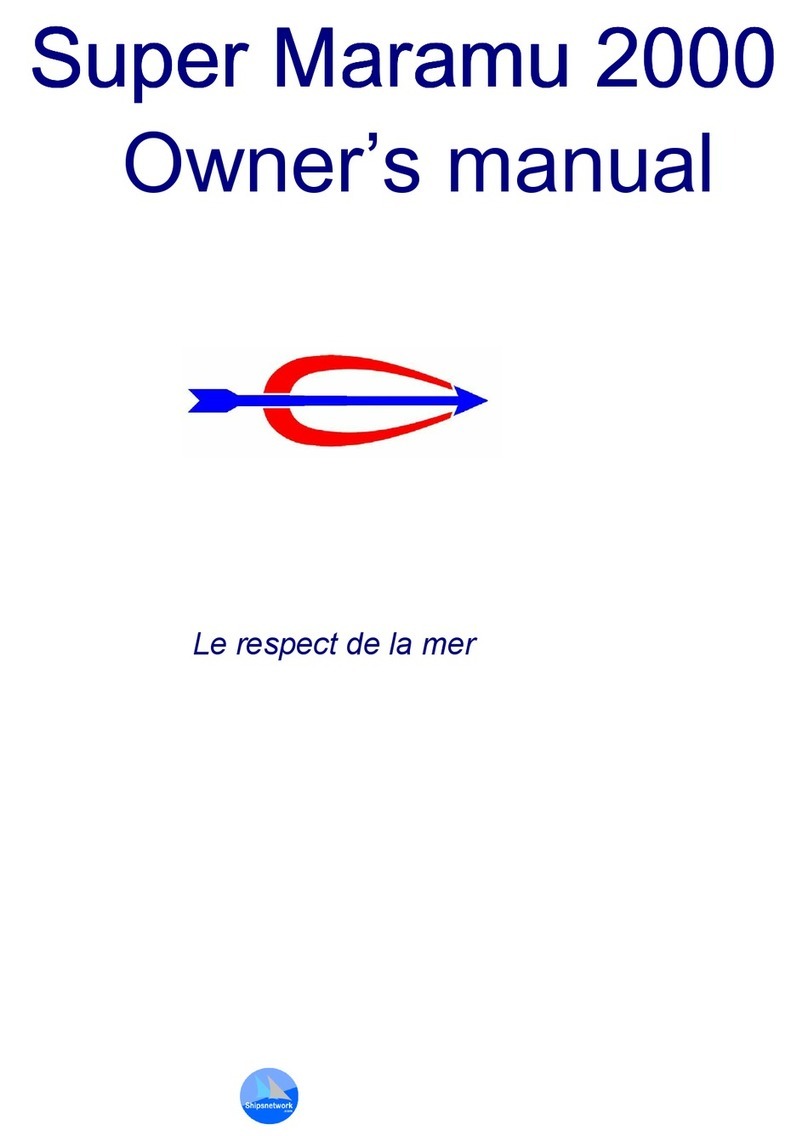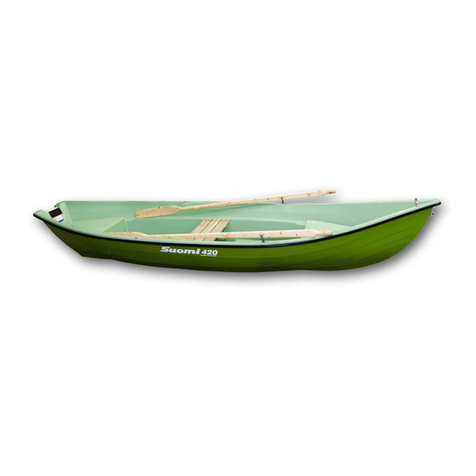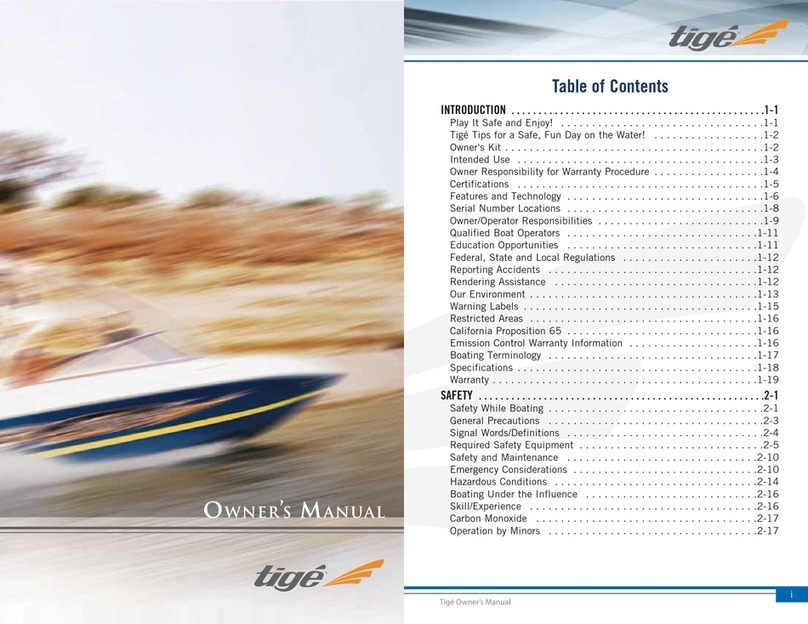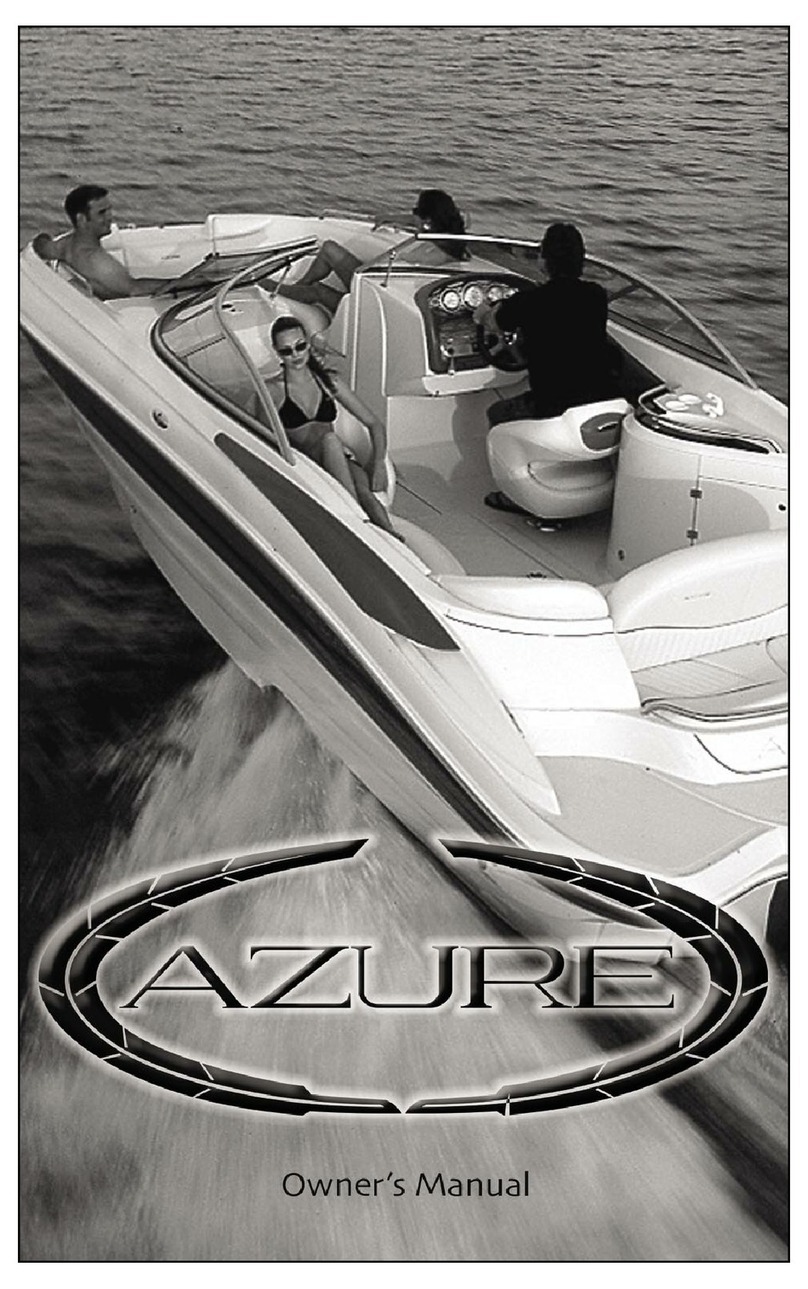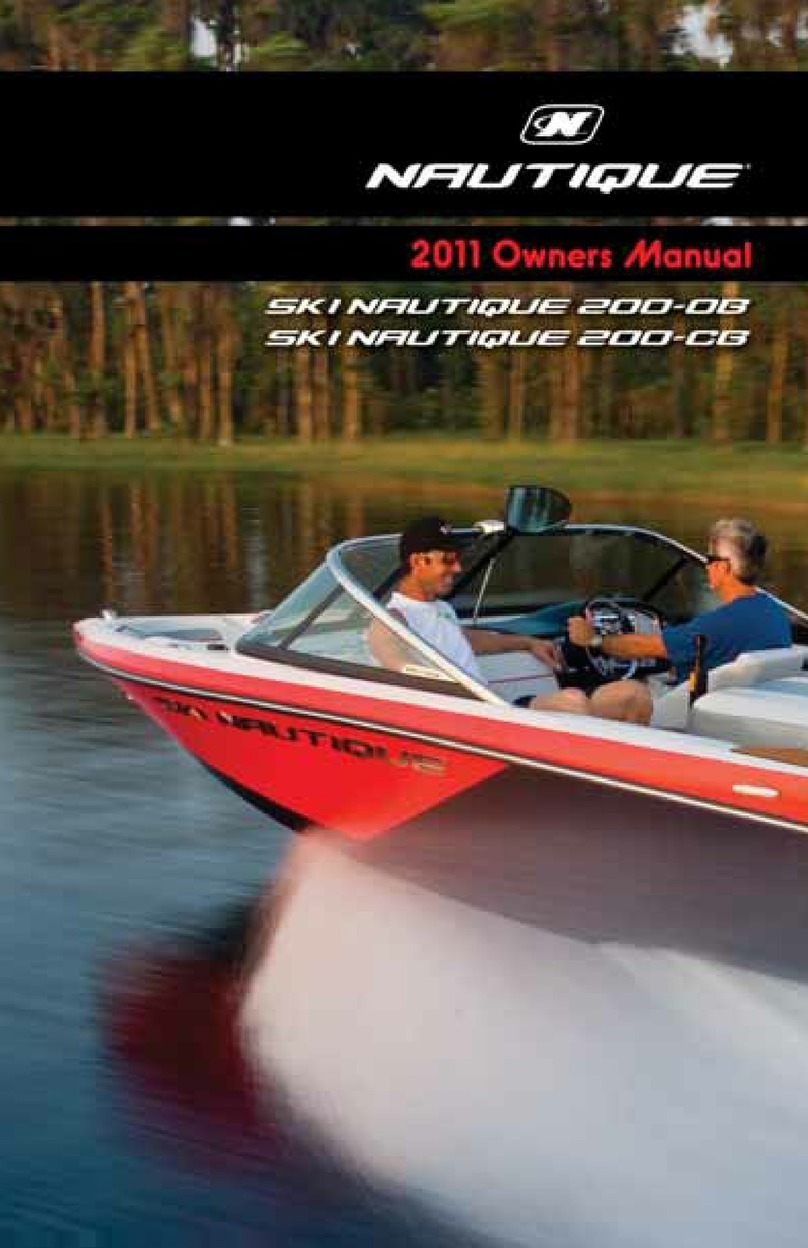Flexboat Miniflex-S User manual

O
OO
O
O
OO
Ow
ww
w
w
ww
wn
nn
n
n
nn
ne
ee
e
e
ee
er
rr
r
r
rr
r'
''
'
'
''
's
ss
s
s
ss
s
m
mm
m
m
mm
ma
aa
a
a
aa
an
nn
n
n
nn
nu
uu
u
u
uu
ua
aa
a
a
aa
al
ll
l
l
ll
l
S
SS
S
S
SS
Sm
mm
m
m
mm
ma
aa
a
a
aa
al
ll
l
l
ll
ll
ll
l
l
ll
l
b
bb
b
b
bb
bo
oo
o
o
oo
oa
aa
a
a
aa
at
tt
t
t
tt
ts
ss
s
s
ss
s
u
uu
u
u
uu
up
pp
p
p
pp
p
t
tt
t
t
tt
to
oo
o
o
oo
o
1
11
1
1
11
10
00
0
0
00
0f
ff
f
f
ff
ft
tt
t
t
tt
t

2
Index
1 - Introduction
2 - Flexboat history
3 - Builders Certificates
4 - Vessel Registration
5 - Owner responsibilities
6 - Features of the small boats up to 10 ft
6.1 - Miniflex, MiniflexS and TD 8 line of foldable boats
6.1.1 - Assembly, disassembly and transportation of boats with folding bottom
6.2 - TD 10 boat that can be disassembled
6.1.2 - Assembly, disassembly and transportation of boats that can be disassembled
6.3 - Mini SR, SR 9.5, SR 10 and SR 10 S line of rigid bottom boats
7 - Dimensions
8 - Knowing the Miniflex
9 - Knowing the Miniflex S
10 - Knowing the TD 8
11 - Knowing the TD 10
12 - Knowing the Mini SR
13 - Knowing the SR 9.5
14 - Knowing the SR 10
15 - Knowing the SR 10 S
16 - Basic items for all models
17 - How to inflate your Flexboat
18 - Maximum capacity
19 - Engine ratings
20 - Maintenance and cleaning
20.1 - Hull and cockpit cleaning
20.2 - Tube cleaning
20.2.1 - Using the Hypalon cleaning Blue Kit
20.3 - Stainless steel cleaning
20.4 - Windshield cleaning
20.5 - Upholstery cleaning
20.6 - Cleaning products NOT TO BE USED on board
21 - Before navigation
21.1 - Complete checklist, still in land
21.2 - In-water checklist
21.3 - Engine starting checklist
22- Onboard safety
23 - Anchoring your Flexboat
23.1 - Launching the anchor
23.2 - Retrieving the anchor
24 - Navigation tips
25 - Returning from your trip
26 - Fuel
26.1 - Fueling the boat
26.2 - Using the right fuels
27 - Engine care
28- Small repairs on the tubes
29 - Air valve replacement
30 - Final considerations
31 - Warranty
32 - Warranty card

1 - Introduction
Congratulations! You have just purchased a FLEXBOAT.
A lightweight,
versatile and dynamic vessel. Stability, safety and high capacity a
We only use
the highest quality materials and components to build our boats. The tubes are built with the best
material imported from France, a fabric made of Hypalon, Neoprene and Polyester which is highly hermetic and
extr
emely resistant to abrasion, chemicals, sun rays, and wear & tear. The use of those materials guarantees
Flexboat inflatables’ a
superior durability.
Boating means spending
good moments in the water
r
ead this manual. Here you will learn how to h
how to take care of your boat, do some basic troubleshooting,
find information about its wa
rranty. Our goal is helping you getting the most of your Flexboat so you can enjoy it
safely.
Our products
are under constant development and improvement. All images, drawings, descriptions and
specifications in this manual reflect the most current models
Flexboat reserves the right to do changes to this Manual at any time as needed.
2 – Flexboat history
Late 1988 Jaime Jose Alves Silva, an entrepreneur from Rio de Janeiro, decided to settle in Sao Paulo after
travelling to Italy and France se
arching for technology and for the most advanced materials in order to start
building the best inflatable boats in Brazil.
FLEXBOAT CONSTRUCOES NAUTICAS LTDA was born in 1990 in its facility located in the city of Atibaia, 40
miles from the city of Sao Pa
ulo, on a 270,000 s
Atibaia was chosen due to its prime location as a transportation hub and also because it is close to the main
marine markets in Brazil's south / southeast regions.
Since then 2
8 years have demanded lots of work and dedication. During this period FLEXBOAT has created a
brand name which is a reference of quality. It has turned into a synonym of inflatable boats.
Since its inception FLEXBOAT has been using Hypalon (special fabric
from France) to build its tubes. This material and its incomparable features guarantees the boats will have the
highest safety standard. It makes sure the boats will last longer. When used in conjunction with other hi
raw materials and components and when handled by a team of highly trained and qualified workers the final
result is FLEXBOAT, the best inflatable boat made in Brazil.
After starting building small inflatables up to 12 feet long Flexboat kept on
release of the SR 1000, the largest (33 ft) and most advanced inflatable build in Brazil. Until now more than
15,000 boats were built and sold in Brazil, USA, Caribbean and Europe.
In 2005 FLEXBOAT started the develo
pment of boats focused on military use and since then we have become
the main vendor for Brazil armed forces. Federal Police, Navy, Firemen, First Responders, IBAMA and Ambient
Police are among FLEXBOAT customers.
FLEXBOAT is looking to the future and wor
offering larger boats with a cabin, and other innovations, both for the Brazilian and International markets. In the
military and professional sectors, FLEXBOAT is developing a new line of p
This is FLEXBOAT!
Best regards,
THE FLEXBOAT TEAM
Owner’s Manual –
Small boats up to 10ft
Congratulations! You have just purchased a FLEXBOAT.
versatile and dynamic vessel. Stability, safety and high capacity a
re just some of its strengths.
the highest quality materials and components to build our boats. The tubes are built with the best
material imported from France, a fabric made of Hypalon, Neoprene and Polyester which is highly hermetic and
emely resistant to abrasion, chemicals, sun rays, and wear & tear. The use of those materials guarantees
superior durability.
good moments in the water
.
To make sure you achieve this we strongly suggest you
ead this manual. Here you will learn how to h
andle your boat and how to use
it in a safe way. You will also learn
how to take care of your boat, do some basic troubleshooting,
and
how to properly maintain it. And you will also
rranty. Our goal is helping you getting the most of your Flexboat so you can enjoy it
are under constant development and improvement. All images, drawings, descriptions and
specifications in this manual reflect the most current models
available.
Flexboat reserves the right to do changes to this Manual at any time as needed.
Late 1988 Jaime Jose Alves Silva, an entrepreneur from Rio de Janeiro, decided to settle in Sao Paulo after
arching for technology and for the most advanced materials in order to start
building the best inflatable boats in Brazil.
FLEXBOAT CONSTRUCOES NAUTICAS LTDA was born in 1990 in its facility located in the city of Atibaia, 40
ulo, on a 270,000 s
q ft area right across the Fernã
o Dias Highway. The city of
Atibaia was chosen due to its prime location as a transportation hub and also because it is close to the main
marine markets in Brazil's south / southeast regions.
8 years have demanded lots of work and dedication. During this period FLEXBOAT has created a
brand name which is a reference of quality. It has turned into a synonym of inflatable boats.
Since its inception FLEXBOAT has been using Hypalon (special fabric
based on rubber and neoprene, imported
from France) to build its tubes. This material and its incomparable features guarantees the boats will have the
highest safety standard. It makes sure the boats will last longer. When used in conjunction with other hi
raw materials and components and when handled by a team of highly trained and qualified workers the final
result is FLEXBOAT, the best inflatable boat made in Brazil.
After starting building small inflatables up to 12 feet long Flexboat kept on
expanding its product line until the
release of the SR 1000, the largest (33 ft) and most advanced inflatable build in Brazil. Until now more than
15,000 boats were built and sold in Brazil, USA, Caribbean and Europe.
pment of boats focused on military use and since then we have become
the main vendor for Brazil armed forces. Federal Police, Navy, Firemen, First Responders, IBAMA and Ambient
Police are among FLEXBOAT customers.
FLEXBOAT is looking to the future and wor
king onto increasing its product offering in the leisure market by
offering larger boats with a cabin, and other innovations, both for the Brazilian and International markets. In the
military and professional sectors, FLEXBOAT is developing a new line of p
roducts that will be second to none.
Small boats up to 10ft
3
re just some of its strengths.
the highest quality materials and components to build our boats. The tubes are built with the best
material imported from France, a fabric made of Hypalon, Neoprene and Polyester which is highly hermetic and
emely resistant to abrasion, chemicals, sun rays, and wear & tear. The use of those materials guarantees
To make sure you achieve this we strongly suggest you
it in a safe way. You will also learn
how to properly maintain it. And you will also
rranty. Our goal is helping you getting the most of your Flexboat so you can enjoy it
are under constant development and improvement. All images, drawings, descriptions and
Late 1988 Jaime Jose Alves Silva, an entrepreneur from Rio de Janeiro, decided to settle in Sao Paulo after
arching for technology and for the most advanced materials in order to start
FLEXBOAT CONSTRUCOES NAUTICAS LTDA was born in 1990 in its facility located in the city of Atibaia, 40
o Dias Highway. The city of
Atibaia was chosen due to its prime location as a transportation hub and also because it is close to the main
8 years have demanded lots of work and dedication. During this period FLEXBOAT has created a
brand name which is a reference of quality. It has turned into a synonym of inflatable boats.
based on rubber and neoprene, imported
from France) to build its tubes. This material and its incomparable features guarantees the boats will have the
highest safety standard. It makes sure the boats will last longer. When used in conjunction with other hi
gh quality
raw materials and components and when handled by a team of highly trained and qualified workers the final
expanding its product line until the
release of the SR 1000, the largest (33 ft) and most advanced inflatable build in Brazil. Until now more than
pment of boats focused on military use and since then we have become
the main vendor for Brazil armed forces. Federal Police, Navy, Firemen, First Responders, IBAMA and Ambient
king onto increasing its product offering in the leisure market by
offering larger boats with a cabin, and other innovations, both for the Brazilian and International markets. In the
roducts that will be second to none.

3 – Quality you can trust
All our boats are subjected to quality tests before delivery to the customer, guaranteeing a superior level of
quality.
4 - Vessel registration
You should register your boat according to the local laws and regulations. Please contact your nearest marine
authorities or your closest FLEXBOAT dealer if needed
5 – Owner responsibilities
The owner or user is responsible for acknowledging
•Coast Guard registration
•Insurance
•Warranty registration
•Warranty terms and conditions
•
Correct usage and maintenance of the boat and its systems
•Safety equipment
•
Passengers safety preparation and train
•
Knowledge of the boats systems
•
Knowledge of the sea conditions
•Safe practices
•No use of drugs and alcohol
•Environmental regulations
•Accident reports
•Operators license if needed
Owner’s Manual –
Small boats up to 10ft
All our boats are subjected to quality tests before delivery to the customer, guaranteeing a superior level of
You should register your boat according to the local laws and regulations. Please contact your nearest marine
authorities or your closest FLEXBOAT dealer if needed
The owner or user is responsible for acknowledging
and following the requirements and procedures below:
Correct usage and maintenance of the boat and its systems
Passengers safety preparation and train
ing
Knowledge of the boats systems
Knowledge of the sea conditions
Small boats up to 10ft
4
All our boats are subjected to quality tests before delivery to the customer, guaranteeing a superior level of
You should register your boat according to the local laws and regulations. Please contact your nearest marine
and following the requirements and procedures below:

6 -
Features of the small boats up to 10 ft
Flexboat line of small boa
ts was developed to work as support boats for larger vessels and t
friendly boat.
Depending on its bottom style, the small boats are divided into three groups as follows:
a)
Folding boats
b)
Boats that can be disassembled
c)
Boats with rigid bottom
6.1 - Miniflex, Miniflex-S and
TD
Ideal to support larger vessels;
When folded, it
fits into a small carrying bag;
Very light;
Easy to be transported;
Its hydrodynamics
assures excellent p
The trans
om plate and the bottom planks are made of fiberglass thus increasing its durability even
when exposed to bad weather.
6.1.1 Assembly,
disassembly
The foldable boats are very light and fit into a carrying bag which was specially developed for
its transportation. Assembling and disassembling the Miniflex is a simple process that can de
performed by anyone.
Se
S
ee detailed inflating instructions
Owner’s Manual –
Small boats up to 10ft
Features of the small boats up to 10 ft
ts was developed to work as support boats for larger vessels and t
Depending on its bottom style, the small boats are divided into three groups as follows:
Boats that can be disassembled
TD
-8 line of foldable boats
fits into a small carrying bag;
assures excellent p
erformance and maneuverability;
om plate and the bottom planks are made of fiberglass thus increasing its durability even
when exposed to bad weather.
Bottom type:
Flat bottom with
fiberglass planks and Hypalon fabric.
Materials: Tran
som plate and bottom
planks
consist of marine ply
encapsulated with reinforced fiberglass
with orthophthalic polyester resin,
reinforced with
450 g/m² of fabric and
Coremat. Finishing in isopht
coat with NPG and anti
disassembly
and transportation of boats with fold
The foldable boats are very light and fit into a carrying bag which was specially developed for
its transportation. Assembling and disassembling the Miniflex is a simple process that can de
Se
e a step by step explanation below:
ee detailed inflating instructions
in item 17 of this manual.
Small boats up to 10ft
5
ts was developed to work as support boats for larger vessels and t
o be a family
Depending on its bottom style, the small boats are divided into three groups as follows:
om plate and the bottom planks are made of fiberglass thus increasing its durability even
Flat bottom with
fiberglass planks and Hypalon fabric.
som plate and bottom
consist of marine ply
wood
encapsulated with reinforced fiberglass
with orthophthalic polyester resin,
450 g/m² of fabric and
Coremat. Finishing in isopht
halic gel
coat with NPG and anti
UV.
and transportation of boats with fold
ing bottom
The foldable boats are very light and fit into a carrying bag which was specially developed for
its transportation. Assembling and disassembling the Miniflex is a simple process that can de

6.2 -
TD 10 boat that can be disassembled
The TD 10 has a removable bottom. When disassembled it is fitted in two separate carrying bags that can
be transported in any vehi
cle. Transverse and longitudi
bottom panels and assure
rigidity to the bottom during navigation.
6.2
.1 Assembly, disas
disassembled
Owner’s Manual –
Small boats up to 10ft
TD 10 boat that can be disassembled
The TD 10 has a removable bottom. When disassembled it is fitted in two separate carrying bags that can
cle. Transverse and longitudi
nal aluminum profiles guarantee
rigidity to the bottom during navigation.
Bottom ty
pe: V bottom with
fiberglass
and inflatable keel with
Hypalon fabric
Materials: Hypalon f
fiberglass
aluminum profiles.
.1 Assembly, disas
semb
ly and transportation of boats that can be
Small boats up to 10ft
6
The TD 10 has a removable bottom. When disassembled it is fitted in two separate carrying bags that can
nal aluminum profiles guarantee
a perfect fit for the
pe: V bottom with
and inflatable keel with
Hypalon fabric
.
Materials: Hypalon f
abric, and
with anodyzed
aluminum profiles.
ly and transportation of boats that can be

The TD 10 comes in two separate carrying bags. One bag stores the tubes and the other bag stores
Step 1– Preparing the parts.
Laying the bottom out and
arranging
Step 2 – Installing
the bottom in the boat
Install the bottom parts following their numbers. Start at the bow
stern until you get to part # 5.
Part # 4 should be the last one to be put in place.
the final fitting by applying some down pressure in
adjust the side fabric from the tube to the sides of the floor.
Install the
4 pieces of side aluminum profiles by fitting them to the sides of the floor. Check the final
adjustment of the floor.
Step 3– Inflating the boat
Inflate the tubes. First
pump a little air on each tube to help the bottom to
complete th
e inflation of the tubes. Only after the
inflate the keel of the boat. Inflate the keel until the bottom it straight and has a V shape.
Owner’s Manual –
Small boats up to 10ft
The TD 10 comes in two separate carrying bags. One bag stores the tubes and the other bag stores
disassembled bottom.
arranging
the rubber parts.
the bottom in the boat
Install the bottom parts following their numbers. Start at the bow
with part # 1
and move your way to the
Part # 4 should be the last one to be put in place.
First
fit part # 4 into part # 5 and slightly raise part #3 to do
the final fitting by applying some down pressure in
order to accommodate
the whole floor
adjust the side fabric from the tube to the sides of the floor.
4 pieces of side aluminum profiles by fitting them to the sides of the floor. Check the final
pump a little air on each tube to help the bottom to
accommodate
e inflation of the tubes. Only after the
tubers are
inflated to their correct pressure it is t
inflate the keel of the boat. Inflate the keel until the bottom it straight and has a V shape.
Small boats up to 10ft
7
The TD 10 comes in two separate carrying bags. One bag stores the tubes and the other bag stores
the
and move your way to the
fit part # 4 into part # 5 and slightly raise part #3 to do
the whole floor
in place. Then
4 pieces of side aluminum profiles by fitting them to the sides of the floor. Check the final
accommodate
correctly. Then
inflated to their correct pressure it is t
ime to
inflate the keel of the boat. Inflate the keel until the bottom it straight and has a V shape.

Step 4 – Installing the seat
Fit the seat onto the screw installed on the tube. Tighten the bolts. Repeat on the o
I
nflated keel
6.3-
Mini SR, SR 9.5, SR 10 and SR 10 S line of rigid bottom boats
They all have a rigid fiberglass bottom which makes them suited for a
MINI-SR, SR 9.5 and SR 10
Reinforced fiberglass hull laminated with orthophtalic polyester resin, reinforced with
Coremat finishing in isophth
alic gel coat with NPG and anti
SR 10-S
Reinforced
fiberglass hull laminated with orthophtalic polyester resin, reinforced with
Coremat
, and injected polyurethane foam between the hull and liner
NPG and anti UV.
Owner’s Manual –
Small boats up to 10ft
Fit the seat onto the screw installed on the tube. Tighten the bolts. Repeat on the o
nflated keel
Lifeline
Mini SR, SR 9.5, SR 10 and SR 10 S line of rigid bottom boats
They all have a rigid fiberglass bottom which makes them suited for a
ny kind of use and activity.
Reinforced fiberglass hull laminated with orthophtalic polyester resin, reinforced with
450 g/m² of fabric and
alic gel coat with NPG and anti
-UV.
fiberglass hull laminated with orthophtalic polyester resin, reinforced with
, and injected polyurethane foam between the hull and liner
. Finishing in isopht
Small boats up to 10ft
8
Fit the seat onto the screw installed on the tube. Tighten the bolts. Repeat on the o
ther side.
ny kind of use and activity.
450 g/m² of fabric and
fiberglass hull laminated with orthophtalic polyester resin, reinforced with
450 g/m² of fabric and
. Finishing in isopht
halic gel coat with

7
– Dimensions
Miniflex
Miniflex S
Length overall
(outside) 6 ft 7 in
7 ft 5 in
Length overall
(inside) 4 ft 4 in
5 ft 2 in
Beam
(outside) 4 ft 4 ft 4 in
Beam (inside) 1 ft 10 in
2 ft 2 in
Tube diameter 1 ft 1 in
1 ft 1 in
Quantity of
chambers
2
2
Max person
capacity
2
3
Max HP
recommended 3.3hp 4hp
Product line Foldable
Foldable
Weight (w/o
engine) 46 lb 62 lb
8
– Knowing the Miniflex
Owner’s Manual –
Small boats up to 10ft
TD-8 TD-10 Mini SR SR-9.5
8 ft 2 in
10 ft 7 ft 5 in 9 ft 5 in
5 ft 10 in
7 ft 5 in 5 ft 2 in 6 ft 5 in
5 ft 5 ft 4 in 4 ft 4 in 5 ft 5 in
2 ft 5 in
2 ft 6 in 2 ft 2 in 2 ft 4 in
1 ft 1 in
1 ft 4 in /
1 ft 2 in 1 ft 1 in 1 ft 5 in
2
3
2
2
4
5
3
5
5hp 15hp 4hp 8hp
Foldable
Disassembled
Rigid
bottom
Rigid
bottom
82 lb 106 lb 73 lb 128 lb
Small boats up to 10ft
9
SR-10 SR-10 S
10 ft 3 in 10 ft
7 ft 3 in 7 ft 6 in
5 ft 8 in 5 ft 4 in
2 ft 9 in 2 ft 6 in
1 ft 5 in 1 ft 4 in /
1 ft 2 in
3
2
5
5
15hp 15hp
Rigid
bottom
Rigid
bottom
150 lb 132 lb

Items located at the transom plate:
Nylon plate
Boat ID label
Drainplug with valve
There is an internal
rubber handle in the bow
9
– Knowing the Miniflex-S
Owner’s Manual –
Small boats up to 10ft
rubber handle in the bow
, vulcanized to the tube.
Triangular shaped stainless steel
fixture in the bow, for towing, anchoring
and tying to the dock.
Small boats up to 10ft
10
Triangular shaped stainless steel
fixture in the bow, for towing, anchoring

Items located at the transom plate:
Nylon plate
Boat ID label
Drainplug with valve
Stainless
steel D ring in the bow
EVA padded fiberglass captain seat.
Triangular shaped stainless steel fixture in the bow, for towing, anchoring and tying to the dock.
There is a internal rubber handle in the boat, vulcanized to the tube, and a triangular shaped
fixture in the bow, for towing, anchoring and tying to the dock.
10
– Knowing theTD-8
Items located at the transom plate:
Nylon plate
Boat ID label
Drainplug with valve
Two polyamide straps for transpo
Stainless steel D ring in the bow
EVA padded fiberglass captai
n seat.
Triangular shaped stainless steel fixture in the bow, for towing, anchoring and tying to the dock.
Owner’s Manual –
Small boats up to 10ft
steel D ring in the bow
EVA padded fiberglass captain seat.
Triangular shaped stainless steel fixture in the bow, for towing, anchoring and tying to the dock.
There is a internal rubber handle in the boat, vulcanized to the tube, and a triangular shaped
fixture in the bow, for towing, anchoring and tying to the dock.
Two polyamide straps for transpo
rtation
Stainless steel D ring in the bow
n seat.
Triangular shaped stainless steel fixture in the bow, for towing, anchoring and tying to the dock.
Small boats up to 10ft
11
Triangular shaped stainless steel fixture in the bow, for towing, anchoring and tying to the dock.
There is a internal rubber handle in the boat, vulcanized to the tube, and a triangular shaped
stainless steel
Triangular shaped stainless steel fixture in the bow, for towing, anchoring and tying to the dock.

Bow
TD 8
carrying bag
11– Knowing the TD 10
Owner’s Manual –
Small boats up to 10ft
Two paddles
carrying bag
Small boats up to 10ft
12
Two paddles

Items located at the transom plate:
Nylon plate
Boat ID label
Drainplug with valve
EVA padded fiberglass captain
seat.
Triangular shaped stainless steel fixture in the bow, for t
Inflatable keel.
Towing fixture
12 – Knowing the Mini-SR
Owner’s Manual –
Small boats up to 10ft
seat.
Triangular shaped stainless steel fixture in the bow, for t
owing, anchoring and tying to the dock.
Seat Air valve
Small boats up to 10ft
13
owing, anchoring and tying to the dock.
Paddle

Items located at the transom plate:
Nylon plate
Boat ID label
Drainplug with valve
EVA padded fiberglass
captain
Rubber handle in the bow, vulcanized to the tube
13 – Knowing the SR 9.5
Items located at the transom plate:
Nylon plate
Boat ID label
Drainplug with valve
Two stainless steel U bolts
EVA padded fiberglass
captain
U ring
located in the bow, inside the boat.
Owner’s Manual –
Small boats up to 10ft
captain
seat.
Rubber handle in the bow, vulcanized to the tube
.
captain
seat.
located in the bow, inside the boat.
Small boats up to 10ft
14

1 2
1-Fiberglass seat; 2-Transom
plate
14 – Knowing the SR-10
Items located at the transom plate:
Nylon plate
Boat ID label
Drain plug with valve
T
wo stainless steel lifting rings
Tw
o stainless steel tow rings
Owner’s Manual –
Small boats up to 10ft
3 4
plate
; 3-U ring; 4-Fuel tank location; 5-
Transom with
wo stainless steel lifting rings
o stainless steel tow rings
EVA padded fiberglass captain seat
Nylon flag pole located in the tube.
Fuel tank compartment located in the bow improves weight
distribution offering quick planning and great overall perfo
Bow storage compartment with fiberglass cover and stainless
steel latch with 2 in
ternal stainless steel rings, fuel tank and
fuel hose and clamps. This
compartment serves as a bow
Two vents
Two lifting rings
Stainless steel tow ring in
the bow, located at the fiberglass hull
bow.
Small boats up to 10ft
15
5
Transom with
drain valve
Fuel tank compartment located in the bow improves weight
distribution offering quick planning and great overall perfo
rmance.
Bow storage compartment with fiberglass cover and stainless
ternal stainless steel rings, fuel tank and
with
compartment serves as a bow
seat.
the bow, located at the fiberglass hull

Fuel tan compartment
15 - Knowing the SR 10-S
Items located at the transom plate:
Nylon plate
Boat ID label
Drain plug with valve
Two stainless steel tow rings
EVA padded fiberglass captain seat.
Internal
stainless steel ring to tie the fuel tank.
Stainless steel tow ring
Conic shaped tubes
Double fiberglass hull with injected polyurethane between hull and liner
Ru
bber handle on the sides of the tubes
Transom plate
Rubber handle
Owner’s Manual –
Small boats up to 10ft
Fuel tan compartment
EVA padded seat
Two stainless steel tow rings
EVA padded fiberglass captain seat.
stainless steel ring to tie the fuel tank.
Double fiberglass hull with injected polyurethane between hull and liner
bber handle on the sides of the tubes
Rubber handle
Fiberglass seat
T
Small boats up to 10ft
16
Flag pole
T
ransom and drain valve

16 - Basic items for all models
•
Two aluminum paddles with nylon blades. Total
•Small foot pump
Repair kit containing:
1 Plastic container (the kits container)
5 pc Hypalon fabric 5 in x 4 in
5 pc Hypalon fabric 2 1/2 in diameter
1 pc Hypalon adhesive 3 ounces
1 pc air valve adapter
1 pc 120 metal sandpaper
1 pc Flexboat owners’ manual
1 pc drain plug membrane
1 pc rubber plug
Note:
The Hypalon fabric color matches the color of the tubes of the boat.
17 - Inflating your Flexboat
All FLEXBOAT boats are equipped with a pump.
The air valves have a devi
ce that when pressed releases the air in the tubes. If this device is pressed and turned
clockwise ¼ turn, the valve will remain op
Owner’s Manual –
Small boats up to 10ft
Two aluminum paddles with nylon blades. Total
length 3 ft 7 in.
1 Plastic container (the kits container)
5 pc Hypalon fabric 2 1/2 in diameter
1 pc Hypalon adhesive 3 ounces
The Hypalon fabric color matches the color of the tubes of the boat.
All FLEXBOAT boats are equipped with a pump.
ce that when pressed releases the air in the tubes. If this device is pressed and turned
open and the tube will empty in seconds. If you ju
Small boats up to 10ft
17
ce that when pressed releases the air in the tubes. If this device is pressed and turned
just want to decrease the

amount of air inside the tubes, just press it (withou
Along with the pump, you will find an adapter that should be screwed to the air valve and fitted into the pump
hose so that there is no air loss when inflating.
First inflate all the air chambers a little, without much p
the chambers until they are stiff and without wrinkles.
The air pressure of the chambers should be kept at 3 psi. In practice, the tubes are correctly inflated when by
pressing them with the finger
s they don't yield more than ¼ of an inch. (6 mm)
Remember that the action of the sun increases the air pressure in the tubes. If you intend to leave your inflatable
out of the water and exposed to the sun for too long you should relieve the air pres
central part of the air valve a few times. This problem does not occur when you are boating, as the contact with
the water cools the tubes.
18 – Capacity
FLEXBOAT boats have an identification plate indicating the maximum
be transported under normal conditions. The nameplate is located on the hull near the transom
Weight above recommended violates regulations. Do not carry more weight or passengers than what is on the
nameplate.
T
he number of seats is not necessarily the indication of the number of people that the boat can safely carry.
Weight above recommended, improper loading and inadequate weight distribution are significant c
accidents. Always use
extra caution in rou
19 – Engine ratings
We recommend that you do not install motors with higher horsepower than what is stated on the nameplate
affixed to the product.
Inflatable boats are light thus require less engine power to do the same job as other types
of heavier vessels.
Bigger than reasonable motorization in inflatables red
Motorization higher than recommended may cause:
►Accidents
►
Hurt the certification and construction standards.
►
Put too much weight in the stern whi
►
Greater difficulty in finding the right the distribution.
►
Damages to the transom.
Owner’s Manual –
Small boats up to 10ft
amount of air inside the tubes, just press it (withou
t turning it) as often as needed.
Along with the pump, you will find an adapter that should be screwed to the air valve and fitted into the pump
hose so that there is no air loss when inflating.
First inflate all the air chambers a little, without much p
ressure, just to shape the boat.
Then complete the air in
the chambers until they are stiff and without wrinkles.
The air pressure of the chambers should be kept at 3 psi. In practice, the tubes are correctly inflated when by
s they don't yield more than ¼ of an inch. (6 mm)
Remember that the action of the sun increases the air pressure in the tubes. If you intend to leave your inflatable
out of the water and exposed to the sun for too long you should relieve the air pres
sure slightly by squeezing the
central part of the air valve a few times. This problem does not occur when you are boating, as the contact with
FLEXBOAT boats have an identification plate indicating the maximum
capacity of persons and cargo possible to
be transported under normal conditions. The nameplate is located on the hull near the transom
Weight above recommended violates regulations. Do not carry more weight or passengers than what is on the
he number of seats is not necessarily the indication of the number of people that the boat can safely carry.
Weight above recommended, improper loading and inadequate weight distribution are significant c
extra caution in rou
gh waters.
We recommend that you do not install motors with higher horsepower than what is stated on the nameplate
Inflatable boats are light thus require less engine power to do the same job as other types
Bigger than reasonable motorization in inflatables red
uces stability and steerability.
Motorization higher than recommended may cause:
Hurt the certification and construction standards.
Put too much weight in the stern whi
ch will raise the bow.
Greater difficulty in finding the right the distribution.
Damages to the transom.
Small boats up to 10ft
18
Along with the pump, you will find an adapter that should be screwed to the air valve and fitted into the pump
Then complete the air in
The air pressure of the chambers should be kept at 3 psi. In practice, the tubes are correctly inflated when by
Remember that the action of the sun increases the air pressure in the tubes. If you intend to leave your inflatable
sure slightly by squeezing the
central part of the air valve a few times. This problem does not occur when you are boating, as the contact with
capacity of persons and cargo possible to
be transported under normal conditions. The nameplate is located on the hull near the transom
Weight above recommended violates regulations. Do not carry more weight or passengers than what is on the
he number of seats is not necessarily the indication of the number of people that the boat can safely carry.
Weight above recommended, improper loading and inadequate weight distribution are significant c
auses of
We recommend that you do not install motors with higher horsepower than what is stated on the nameplate
Inflatable boats are light thus require less engine power to do the same job as other types

20 -
Maintenance and cleaning of your Flexboat
20.1 –
Hull and deck cleaning (Fiberglass parts)
The main care is with the
gel coat
waterproofs and protects the hull. Washing the hull with fresh water whenever possible helps to conserve
it.
Once a year, it is
recommended
safe option) or with mild soap, dry it thoroughly and apply a layer of high
surface of the hull. Afterwards, just polish it with a dry cloth.
water. Never use petrol, acetone
If the boat stays in the water, it is important to remove it periodically to clean the hull below the waterline.
Barnacles should be removed with a wooden scraper or plastic spatula, so as not to damage the gelco
or the bottom paint.
The inside of the boat also needs to be aired and cleaned frequently, especially if there are mattresses,
carpets, rugs, and other accessories that could become moldy.
-
Gel Coat surfaces are slippery
-
Be careful while applying the wax.
FIRE OR EXPLOSION HAZARD: Cleaning products may be flammable, explosive
and / or cause personal injury.
20.2 – Tube cleaning
Wash inflatable tubes with clean fresh water and neutral detergent. Use a soft brush to remove stains.
Clean the valves regularly with neutral detergent and a small brush. Do not use silicone,
petroleum based products.
If you purchase and use the Hypalon BLUE KIT for cleaning Hypalon, you will ensure the color and
extend the life of your Flexboat over many years.
Make sure the boat is completely dry before covering it during storage
Do not use plastic tarps as they do not breathe. The recommended ones are the acrylic tarpaulins.
20
.2.1 Using the BLUE KIT to clean the Hypalon
In order to ensure the efficiency of the cleaning kit, we recommend that you follow the instructions
carefu
lly and use appropriate safety equipment when handling the product.
STEP 1 -
NEW MAGIC Cleaner (For frequent cleaning)
1. Spray the product on surfaces of 2 ft X 2 ft
2. Wipe with a soft brush or sponge
3. Rinse with clean water
4. Wipe dry with a soft c
loth
Owner’s Manual –
Small boats up to 10ft
Maintenance and cleaning of your Flexboat
Hull and deck cleaning (Fiberglass parts)
gel coat
, a type of poly
ester based paint that forms the outer layer of the boat,
waterproofs and protects the hull. Washing the hull with fresh water whenever possible helps to conserve
recommended
to wash the entire hull with water and mild detergent (dis
safe option) or with mild soap, dry it thoroughly and apply a layer of high
-
quality wax on the entire
surface of the hull. Afterwards, just polish it with a dry cloth.
Remove stains using detergent diluted with
water. Never use petrol, acetone
or any solvent based on Acetone or Toluol.
If the boat stays in the water, it is important to remove it periodically to clean the hull below the waterline.
Barnacles should be removed with a wooden scraper or plastic spatula, so as not to damage the gelco
The inside of the boat also needs to be aired and cleaned frequently, especially if there are mattresses,
carpets, rugs, and other accessories that could become moldy.
WARNING!
SLIPPERY SURFACES:
Gel Coat surfaces are slippery
when wet.
Take extreme care when walking on a
wet surface.
Be careful while applying the wax.
Make sure your paths are not slippery.
FIRE OR EXPLOSION HAZARD: Cleaning products may be flammable, explosive
and / or cause personal injury.
Read the cleani
ng instructions carefully before
use.
Wash inflatable tubes with clean fresh water and neutral detergent. Use a soft brush to remove stains.
Clean the valves regularly with neutral detergent and a small brush. Do not use silicone,
If you purchase and use the Hypalon BLUE KIT for cleaning Hypalon, you will ensure the color and
extend the life of your Flexboat over many years.
Make sure the boat is completely dry before covering it during storage
.
Do not use plastic tarps as they do not breathe. The recommended ones are the acrylic tarpaulins.
.2.1 Using the BLUE KIT to clean the Hypalon
In order to ensure the efficiency of the cleaning kit, we recommend that you follow the instructions
lly and use appropriate safety equipment when handling the product.
NEW MAGIC Cleaner (For frequent cleaning)
1. Spray the product on surfaces of 2 ft X 2 ft
2. Wipe with a soft brush or sponge
3. Rinse with clean water
loth
Small boats up to 10ft
19
ester based paint that forms the outer layer of the boat,
waterproofs and protects the hull. Washing the hull with fresh water whenever possible helps to conserve
to wash the entire hull with water and mild detergent (dis
hwasher is a
quality wax on the entire
Remove stains using detergent diluted with
If the boat stays in the water, it is important to remove it periodically to clean the hull below the waterline.
Barnacles should be removed with a wooden scraper or plastic spatula, so as not to damage the gelco
at
The inside of the boat also needs to be aired and cleaned frequently, especially if there are mattresses,
Take extreme care when walking on a
Make sure your paths are not slippery.
FIRE OR EXPLOSION HAZARD: Cleaning products may be flammable, explosive
ng instructions carefully before
Wash inflatable tubes with clean fresh water and neutral detergent. Use a soft brush to remove stains.
Clean the valves regularly with neutral detergent and a small brush. Do not use silicone,
grease or
If you purchase and use the Hypalon BLUE KIT for cleaning Hypalon, you will ensure the color and
Do not use plastic tarps as they do not breathe. The recommended ones are the acrylic tarpaulins.
In order to ensure the efficiency of the cleaning kit, we recommend that you follow the instructions

COMMENTS:
For boats that are new or in very good condition, or in case of frequent cleaning we recommend
diluting the product up to 1x
1 with water.
STEP 2 -
SHMUFFEX Deep Cleaner (for deep cleaning and disrupting the action of
microorganisms)
1. Sp
ray the product directly on the surface to be cleaned.
2. Wait for the action of the active ingredient for at least one hour, do not brush.
3. Rinse with clean water
4. Wipe dry with a soft cloth
COMMENTS:
Avoid prolonged contact with metal surfaces.
STEP 3 – GUMEMP
100 Sealant (To seal and create a protective film)
1. Spray the product evenly
2. Wipe with a cloth moistened with the product and allow
3. Wipe again with a clean, dry cloth.
COMMENTS:
The drying time may vary according to temperat
product.
20.3 – St
ainless steel hardware cleaning
Your Flexboat has several STAINLESS STEEL parts that require special care to prevent CORROSION.
There are places in the ocean where the water is cleaner a
clean, and there are places in the ocea
cleaner and saltier the water is where you are using your boat, the more corrosion problems you will
have.
Some people believe stainless steel does not rust. It does. All stainless steels
in its composition. Corrosion on any steel will mostly depend on the carbon level, the presence of
contamination in the water, and electrolysis.
Flexboat uses first-
class raw materials in its products but even the best quality stainless steel is subject
to corrosion. Simple contact with a tool made of regular
another manufacturer
may contaminate an
It is normal for electrons to "leal" through the cracks (where stainless steel parts make contact with
fiberglass), and that is where the electrolysis usually begins (corrosion).
Flexboat has been researching and using t
to date we can state that only frequent cleaning with fresh water and soap can keep the corrosion
process under control.
After each use of the boat in saltwater, always clean the stainless steel
Detergent or ammonia cleaner may also be used).
To remove rust spots from stainless steel parts, the simplest and easiest way is using Semorim, an
oxalic acid based product found in any supermarket. Apply with gloves and
and spread with a soft sponge (do not use anything rough because it may stain or scratch the surface).
Rub it until it covers the entire area to be cleaned. Then wash with soap and water. If the stain does not
come out, repeat th
e process again. Once the part is free of rust, use marine wax, the same one used to
polish hulls, because it will serve to conserve and protect against corrosion. Instead of Semorim, one can
also use chromed metal cleaners or #2 polisher, mixed with cocon
But with Semorim, it's easier, faster, and cheaper.
Important note: n
ever use ab
Owner’s Manual –
Small boats up to 10ft
For boats that are new or in very good condition, or in case of frequent cleaning we recommend
1 with water.
SHMUFFEX Deep Cleaner (for deep cleaning and disrupting the action of
ray the product directly on the surface to be cleaned.
2. Wait for the action of the active ingredient for at least one hour, do not brush.
Avoid prolonged contact with metal surfaces.
100 Sealant (To seal and create a protective film)
2. Wipe with a cloth moistened with the product and allow
drying.
3. Wipe again with a clean, dry cloth.
The drying time may vary according to temperat
ure. Any surface should be dry before using the
ainless steel hardware cleaning
Your Flexboat has several STAINLESS STEEL parts that require special care to prevent CORROSION.
There are places in the ocean where the water is cleaner a
nd there are places where the water is not so
clean, and there are places in the ocea
n
where water is saltier, and places where salt is not present. The
cleaner and saltier the water is where you are using your boat, the more corrosion problems you will
Some people believe stainless steel does not rust. It does. All stainless steels
have some carbon content
in its composition. Corrosion on any steel will mostly depend on the carbon level, the presence of
contamination in the water, and electrolysis.
class raw materials in its products but even the best quality stainless steel is subject
to corrosion. Simple contact with a tool made of regular
steel
or with a stainless steel part or bolt from
may contaminate an
d generate undesirable rust spots.
It is normal for electrons to "leal" through the cracks (where stainless steel parts make contact with
fiberglass), and that is where the electrolysis usually begins (corrosion).
Flexboat has been researching and using t
echniques to avoid or reduce this process for years. However,
to date we can state that only frequent cleaning with fresh water and soap can keep the corrosion
After each use of the boat in saltwater, always clean the stainless steel
parts with soap and water. (Note:
Detergent or ammonia cleaner may also be used).
To remove rust spots from stainless steel parts, the simplest and easiest way is using Semorim, an
oxalic acid based product found in any supermarket. Apply with gloves and
goggles. Pour a few drops
and spread with a soft sponge (do not use anything rough because it may stain or scratch the surface).
Rub it until it covers the entire area to be cleaned. Then wash with soap and water. If the stain does not
e process again. Once the part is free of rust, use marine wax, the same one used to
polish hulls, because it will serve to conserve and protect against corrosion. Instead of Semorim, one can
also use chromed metal cleaners or #2 polisher, mixed with cocon
ut soap. Both have the same effect.
But with Semorim, it's easier, faster, and cheaper.
abrasives
.
Small boats up to 10ft
20
For boats that are new or in very good condition, or in case of frequent cleaning we recommend
SHMUFFEX Deep Cleaner (for deep cleaning and disrupting the action of
2. Wait for the action of the active ingredient for at least one hour, do not brush.
ure. Any surface should be dry before using the
Your Flexboat has several STAINLESS STEEL parts that require special care to prevent CORROSION.
nd there are places where the water is not so
where water is saltier, and places where salt is not present. The
cleaner and saltier the water is where you are using your boat, the more corrosion problems you will
have some carbon content
in its composition. Corrosion on any steel will mostly depend on the carbon level, the presence of
class raw materials in its products but even the best quality stainless steel is subject
or with a stainless steel part or bolt from
It is normal for electrons to "leal" through the cracks (where stainless steel parts make contact with
echniques to avoid or reduce this process for years. However,
to date we can state that only frequent cleaning with fresh water and soap can keep the corrosion
parts with soap and water. (Note:
To remove rust spots from stainless steel parts, the simplest and easiest way is using Semorim, an
goggles. Pour a few drops
and spread with a soft sponge (do not use anything rough because it may stain or scratch the surface).
Rub it until it covers the entire area to be cleaned. Then wash with soap and water. If the stain does not
e process again. Once the part is free of rust, use marine wax, the same one used to
polish hulls, because it will serve to conserve and protect against corrosion. Instead of Semorim, one can
ut soap. Both have the same effect.
This manual suits for next models
7
Table of contents
Other Flexboat Boat manuals
